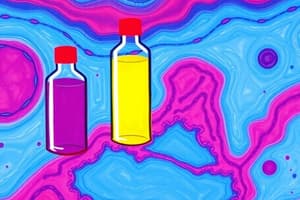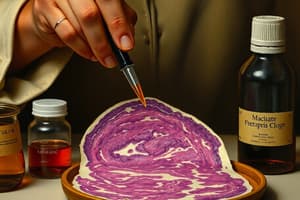Podcast
Questions and Answers
What is the fixative of choice for tissue photography?
What is the fixative of choice for tissue photography?
- B5 FIXATIVE
- ZENKER’S FLUID (correct)
- Lead Fixatives
- MERCURIC CHLORIDE FIXATIVES
Which fixative may produce black granular deposits and requires dezenkerization to remove them?
Which fixative may produce black granular deposits and requires dezenkerization to remove them?
- Chromate Fixatives
- Mercuric Chloride Fixatives (correct)
- Lead Fixatives
- Metalic Fixatives
What is the function of ZENKER’S FLUID fixative?
What is the function of ZENKER’S FLUID fixative?
- Skin Tumor Biopsy
- Pituitary Gland, Blood Containing Organs
- Bone Marrow Biopsies
- Liver, Spleen, Connective Tissue Fiber, Nuclei (correct)
Which fixative is most commonly described as a strong oxidizing reagent?
Which fixative is most commonly described as a strong oxidizing reagent?
What is the process of removing black granular deposits observed when using mercuric chloride fixatives?
What is the process of removing black granular deposits observed when using mercuric chloride fixatives?
What is the main purpose of fixatives in tissue preservation?
What is the main purpose of fixatives in tissue preservation?
What is the optimal pH range for fixation according to the text?
What is the optimal pH range for fixation according to the text?
What is the typical osmolality range for fixation solutions?
What is the typical osmolality range for fixation solutions?
At what rate does the fixative typically penetrate tissues?
At what rate does the fixative typically penetrate tissues?
What is the working temperature range for routine histopathology fixation?
What is the working temperature range for routine histopathology fixation?
Where should the fixation temperature be maintained for TB patients?
Where should the fixation temperature be maintained for TB patients?
Which fixative is commonly used for the chrome-osmium demonstration of acetic acid fixative structures?
Which fixative is commonly used for the chrome-osmium demonstration of acetic acid fixative structures?
Which fixative is recommended for the preservation of nuclear structures and cytoplasmic mitochondria?
Which fixative is recommended for the preservation of nuclear structures and cytoplasmic mitochondria?
What is the function of Trichloroacetic Acid (TCA) as a fixative?
What is the function of Trichloroacetic Acid (TCA) as a fixative?
Which technique involves the use of frozen tissue sections for fixation?
Which technique involves the use of frozen tissue sections for fixation?
What is the optimum rapid fixation temperature as mentioned in the text?
What is the optimum rapid fixation temperature as mentioned in the text?
What is the primary goal of the fixation process in histopathology?
What is the primary goal of the fixation process in histopathology?
Why is fixation considered a critical step in routine histopathology?
Why is fixation considered a critical step in routine histopathology?
What are fixatives in the context of histopathology fixation?
What are fixatives in the context of histopathology fixation?
When is fixation typically performed in histopathology?
When is fixation typically performed in histopathology?
Which of the following best describes the secondary goal of fixation in histopathology?
Which of the following best describes the secondary goal of fixation in histopathology?
Why will improperly fixed tissues cause problems in routine histopathology?
Why will improperly fixed tissues cause problems in routine histopathology?
What is the special consideration for fixation of hollow organs like intestines and stomach?
What is the special consideration for fixation of hollow organs like intestines and stomach?
Which fixative becomes a part of the tissue due to its mechanism?
Which fixative becomes a part of the tissue due to its mechanism?
What is the special consideration in fixation for hard tissues like nails and bones?
What is the special consideration in fixation for hard tissues like nails and bones?
What is the purpose of cytoplasmic fixatives?
What is the purpose of cytoplasmic fixatives?
What is the classification of fixatives based on composition if they consist of two or more fixatives?
What is the classification of fixatives based on composition if they consist of two or more fixatives?
Which fixative is appropriate when determining the presence of mucopolysaccharides in cells or tissues?
Which fixative is appropriate when determining the presence of mucopolysaccharides in cells or tissues?
Flashcards are hidden until you start studying
Study Notes
Fixatives in Histopathology
- The fixative of choice for tissue photography is not specified in the text.
Fixative Characteristics
- Mercuric chloride fixative may produce black granular deposits, which require dezenkerization to remove.
- ZENKER'S FLUID fixative is used to preserve nuclear structures and cytoplasmic mitochondria.
- Chromic acid fixative is commonly used for the chrome-osmium demonstration of acetic acid fixative structures.
- Osmium tetroxide is a strong oxidizing reagent.
- Trichloroacetic Acid (TCA) is used as a fixative for tissue preservation.
Fixation Process
- Dezenkerization is the process of removing black granular deposits observed when using mercuric chloride fixatives.
- The primary goal of the fixation process in histopathology is to preserve tissue morphology and prevent autolysis.
- Fixation is considered a critical step in routine histopathology because it allows for the preservation of tissue structure and prevents artifacts.
- The optimal pH range for fixation is not specified in the text.
- The typical osmolality range for fixation solutions is not specified in the text.
- Fixatives typically penetrate tissues at a rate of 1-2 mm per hour.
- The working temperature range for routine histopathology fixation is 4-20°C.
- For TB patients, the fixation temperature should be maintained at 4°C.
Special Considerations
- Fixation of hollow organs like intestines and stomach requires special consideration, as they may be prone to collapse.
- Fixation of hard tissues like nails and bones requires special consideration, as they may be difficult to fix.
- Cytoplasmic fixatives are used to preserve the cytoplasm of cells.
- Formalin becomes a part of the tissue due to its mechanism.
- The classification of fixatives based on composition is that fixatives consisting of two or more fixatives are classified as compound fixatives.
- For determining the presence of mucopolysaccharides in cells or tissues, cetylpyridinium chloride is the appropriate fixative.
Techniques
- Cryofixation is a technique that involves the use of frozen tissue sections for fixation.
- The optimum rapid fixation temperature is -30°C to -40°C.
Studying That Suits You
Use AI to generate personalized quizzes and flashcards to suit your learning preferences.




